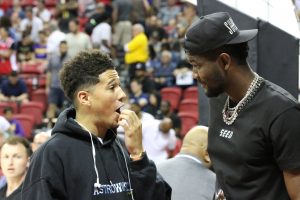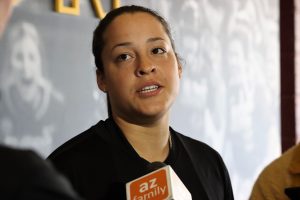- Slug: Sports-Day Sports Stood Still, 1,961 words.
- Photos available.
By Dylan Wilhelm
Cronkite News
PHOENIX – It was Wednesday, March 11, 2020. Devin Booker was enjoying a night off. The evening before, he and the Phoenix Suns had dropped a road game in Portland, but they weren’t scheduled to take the court again until Saturday against Dallas.
“Call of Duty” had just released “Warzone” the night before, so Booker hopped on Twitch with his friends to try out the new battle royale.
What happened next left him speechless.
News had just dropped that Rudy Gobert, a French basketball player in his seventh season with the Utah Jazz, had tested positive for COVID-19. The NBA was suspending its season.
Booker’s squadmate was the first to tell him the news.
“All of the NBA is suspended. Devin, I’m sorry brother but you just heard it from me.”
“It really might be,” Booker said.
“It’s announced.”
“It’s announced? Let me see.”
Booker turned to someone next to him, and that person showed him his phone.
“Bro,” he said. “What the f*** is going on?”
When the NBA shut down on March 11, it was symbolic of the state of the country and set off an unprecedented chain reaction of events. Zoom became a household word, masks became a common item and toilet paper became a hot commodity.
The world was facing a deadly pandemic.
The sports community was impacted as well, with all major sports shutting down for months at a time, causing leagues to reassemble schedules and venues to try and finish paused seasons, including “bubbles” in the NHL, WNBA and NBA.
The NCAA was forced to cancel basketball’s March Madness and baseball’s College World Series, two of its biggest championships, in addition to all other sports.
Booker’s reaction on stream was similar to most reactions around the country, and at the time, no one had any idea what was coming.
A new decade
When the calendar turned to 2020, the novel coronavirus was still not seen as a threat in the United States. Bars, restaurants and businesses were open fully, capacity limits unheard of at the time. China, which was believed to be Ground Zero for the virus, was under scrutiny as doctors and scientists scrambled to learn more.
The first case of the coronavirus was identified in the United States in January, and the first American outbreak was seen in a long-term care facility in Kirkland, Washington. The risk for the general public was still considered minuscule.
Cases were rising, but the usual hygiene practices were preached more than anything else, with friendly reminders to cover coughs and sneezes, wash hands and avoid touching eyes, ears and noses.
In early March, the United States had only hit 1,000 cases.
The Suns had hosted over 17,200 fans in a victory over the 53-10 Milwaukee Bucks on Mar. 8. On Feb. 29, the Coyotes had 17,000. Almost 9,000 had watched in person as Arizona State men’s basketball defeated Washington State on March 7, Senior Night.
“The biggest thing that I remember is two weeks prior being at one of the best environments I have been around at Pauley Pavilion … and then the world just absolutely shutting down,” said ASU Assistant Athletic Director Doug Tammaro, referring to the Sun Devils’ Feb. 27 basketball game at UCLA.
On Mar. 11, the biggest news of the day was supposed to be the sentencing of Harvey Weinstein, the former Hollywood producer accused of numerous sexual assault allegations. He was given 23 years in prison.
The final chapter had closed on that story, opening the door for another: The novel coronavirus was officially declared a pandemic on the same day.
March 11
The Utah Jazz were coming off of a tough home loss to Toronto when they headed to Oklahoma City for a matchup.
Gobert, the 7-foot-1 center, was out with an illness. Two days earlier, he joked around at a press conference, touching reporters’ microphones before the gravity of the virus was understood.
The idea of playing in empty arenas had started to float around the league, and the Golden State Warriors announced that day that their upcoming game against the New Jersey Nets would be played without fans.
Both the Jazz and the Thunder took the court for the beginning of the game, which was moments away from tipping off.
Suddenly, Thunder head medical officer Donnie Strack sprinted out of the tunnel and gathered the officials. They spoke for a few minutes, invited head coaches Quin Snyder and Billy Donovan into the mix, then sent both teams back to the locker room.
When the Thunder PA announced that officials were waiting on “league confirmation” to start the game, confusion and fan frustration took over.
“I’ve been covering the NBA for eight years. I’ve never heard of anybody needing confirmation to start a game,” Sarah Todd, Jazz beat reporter at the Deseret News, recalled in an ESPN “30 for 30” podcast.
After a delay, fans were informed the game was postponed.
Suns guard Chris Paul played for the Thunder at the time and remembers the chaos of that night.
“The uncertainty of it all … all the emotions that went through it, not just us as a team, but with our families, other athletes, fans and people around the world and what everybody dealt with when COVID happened,” Paul said.
Jaws dropped even more when it was learned Gobert had tested positive for COVID-19.
“It didn’t take long for you to realize that if Rudy Gobert was positive there was a chance that just about every single player on every single team could have been exposed just based on who they had all played in the last 14 days,” ESPN’s Ramona Shelburne told “30 for 30.”
Minutes later, the NBA season was suspended.
“The s*** had hit the fan,” Dallas Mavericks owner Mark Cuban told Wired.
ESPN cameras caught the moment Cuban was informed about the suspension, and his reaction represented a majority of people who were also figuring out what was unfolding.
Actor Tom Hanks announced shortly after that he and his wife, actress Rita Wilson, had also tested positive for COVID-19 and were quarantining in Australia.
Whether you were a sports fan or a movie buff, the gravity of the situation seemed to strike everyone instantly.
March 12
The dominoes began to topple the following day, one by one.
“We heard about the basketball game, obviously on social media about that NBA player, but didn’t think anything of it. And then in the morning, we got a text saying, ‘Don’t come to the rink,’” said Coyotes forward Christian Fischer.
NCAA conference tournaments were canceled.
St. Johns and Creighton went to the locker room at halftime of their Big East quarterfinal. They never returned to the floor after the Big East canceled the remainder of its tournament.
The NCAA then announced that all winter and spring seasons and championships were canceled.
The Pac-12 played its first round of games in Las Vegas on March 11. The Sun Devils, who had a bye and were scheduled to play their opening game on March 12 against Washington State, never did. The conference canceled the tournament that morning.
“It was hard on the players,” ASU coach Bobby Hurley said. “We had been playing the best basketball we had all season and we had things to play for. It was a tough day.”
Major League Baseball, Major League Soccer, the National Hockey League and other professional leagues followed the NBA’s lead by pausing or postponing their seasons. In less than 24 hours, professional and collegiate sports in the United States had come to a screeching halt.
“It was kind of surreal how everything just came to an abrupt stoppage,” said Grand Canyon University basketball coach Bryce Drew, who was working for ESPN at the time.
Initially, there was no discussion as to whether seniors at the collegiate level would be granted another year of eligibility. For those athletes, a somber reality set in. They may have taken the field for the last time.
“When we found out, the seniors all sit in the back of the bus, and we all just looked at each other like … what?” ASU softball catcher Maddi Hackbarth said. “I remember texting my mom and being like, ‘I am not OK.’ I ended up crying.”
Her twin sister, outfield Kindra Hackbarth, said, “After time went and it passed and it kind of started feeling real that I wasn’t going to play again unless I got drafted … It was just sad.”
Eventually, both Maddi and Kindra, along with every NCAA athlete, were granted another year of athletic eligibility.
The stoppage didn’t only impact the sports world, but everyday life as well. ASU had already transitioned to online classes for two weeks, and GCU followed suit. Schools across the country did the same. Workplaces also became remote, with Zoom replacing the average office.
Press conferences have become virtual, autograph signings and meet-and-greets became impossible. The little things that many in the world had become accustomed to were gone in the blink of an eye.
March 13 and beyond\
Even as COVID-19 continued to spread throughout the country into the summer, sports eventually returned.
MLB was the first major professional league in the United States to begin play, with its “Summer Camp,” the summer’s spring training. The first regular season games were played on July 23, 119 days after they were originally scheduled to be played.
Due to the pause, MLB only played a 60-game season instead of the usual 162 games.
The NBA resumed its season on July 30 in Orlando, Florida, in a bubble at Disney World, 141 days after the suspension of the season. The WNBA had a bubble of its own at the IMG Academy in Bradenton, Florida.
Paul was in the heart of discussions as National Basketball Players Association President when the league began discussing a restart. More importantly, how the league could restart safely.
“It was a lot, a lot of people played huge roles in making sure it all took place,” Paul said. “When you look back on it, it was pretty impressive to all the people that made it happen.”
The Suns caught the attention of the entire league when they made an 8-0 run in the bubble, only to come up just short of qualifying for the 16-team playoff field.
The NHL began play on Aug. 1 in two bubbles, one for each conference, in Edmonton, Alberta, and Toronto, Ontario.
The Coyotes won the qualifying round to get into the traditional playoffs before losing to the Colorado Avalanche in the first round.
The only league that didn’t have a single cancellation of regular season games was the NFL, which began on Sept. 10, as scheduled. The NFL was forced to cancel the entire preseason and chunks of the offseason, however, which affected rookies looking to get reps before the regular season.
Champions were crowned in those paused seasons, and we now enter the second year of COVID-19 impacting the sports calendar.
Some cities and teams have given the thumbs up on limited attendance at games, with masked fans dotting the stands. Likewise, schools and offices are in the process of making their way back to in-person learning and working.
The Texas Rangers even announced Wednesday that they will be allowing full capacity (40,518) at their home opener on Monday, April 5, a decision that has attracted controversy.
And, of course, the vaccine is making the rounds.
Even with things slowly trending in a positive direction, it is hard not to reminisce about the packed stadiums pre-COVID and buzzer-beaters in March.
“I just want to get back to the way it was,” Tammaro said. “I really wanna get back to the old days.”
For more stories from Cronkite News, visit cronkitenews.azpbs.org.


